Intel Alder Lake-H Core i9-12900HK Review: MSI's Raider GE76 Goes Hybrid
by Brett Howse on January 25, 2022 9:00 AM EST- Posted in
- CPUs
- Intel
- MSI
- Laptops
- Alder Lake
- GE76 Raider
- 12th Gen Core
- Alder Lake-H
Platform Power
Intel’s H-Series processors slot into the 45-Watt class, and have been a staple in performance laptops for years. But with Alder Lake, Intel is now specifying both a base power – what we used to consider Thermal Design Power (TDP) – and maximum turbo power, which has also existed for a long time, but was never formally provided. In theory, a processor would get up to its maximum boost power, which we called Power Level 2 (PL2), and then after a certain amount of time, it would go down to its base power, which we called Power Level 1 (PL1).
That model has been thrown out the window in recent years though. Although the numbers are still relevant, what both AMD and Intel allow manufacturers to do is almost treat their mobile processors as their desktop counterparts. As long as you can cool it, you can realistically throw as much power at the processor as you want, as long as you don’t exceed PL2.
In the thin and light notebook segment, that could mean a normal 15-Watt processor will run at 23 Watts sustained when the user puts the device in its highest performance mode, while in a battery saving or silent mode, the processor will still allow short bursts up to its PL2, but then quickly settle down to its PL1 level to avoid excess battery drain and noise.
In the H-Series, that still happens as well. But thanks to the larger cooling systems, especially in a system like the MSI Raider GE76 that Intel has provided, the cooling system can handle far more than the PL1, so in the interests of performance, the processor is run well over 45 Watts.
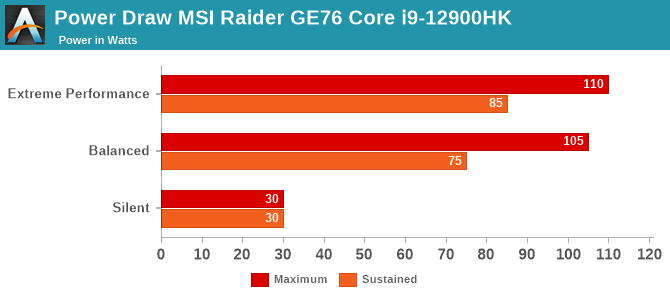
Performing a stress test on the MSI Raider GE76 proves this point very well. When the system is in its maximum performance mode, the processor initially ramps up to an almost insane 110 Watts for a brief moment, and then settles in at a still high 85 Watts for sustained operation.
In its balanced mode, the system brings PL1 down to around 75 Watts, which is still well over the 45-Watt base rating of this processor. Performance will be slightly lower, but so will the noise.
In the Silent mode, MSI drops the power level way down to just 30 Watts, so performance will be impacted significantly, although power consumption grows at a far faster rate than performance, so you don’t lose as much performance as you may think. To see just how big of a drop that is, Cinebench R20 was run in Silent Mode. The result was 3494 versus 6869 in the maximum performance mode. That is 49% less performance for 65% less power, and it is actually less power than that as well because MSI disables the PL2 completely in Silent mode, meaning the device peaks at just 30 Watts instead of 110 Watts.
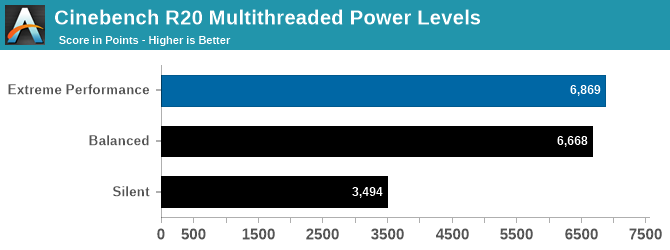
Cinebench runs pretty quickly, so even in Balanced mode the processor is still closer to PL2 than PL1 by the time the test is finished, which is why the scores are so close. On a longer benchmark the difference would be increased, but not significantly, since the sustained power level is similar between the top two modes. If you need that last few percentage points of performance, and do not mind the increased noise, it is available.
Intel and MSI are not the only two to play around with power levels. Pretty much every performance notebook will have some sort of setting to change the power levels and noise. The ASUS G513QY with the AMD Ryzen 9 5900HX has a similar system, and it also draws around 85 Watts in its maximum performance mode on a 45-Watt processor. Really, it comes down to cooling. If you have sufficient cooling, you can extract more performance. The downside is often noise, although that is also dependent on the cooling system design and the size of the notebook.
Multitasking
One of the key ideas around Alder Lake is that it offers six P-Cores and eight E-Cores. Windows 11’s thread scheduler should take advantage of the E-Cores to move intensive workloads to when that task gets moved to the background in Windows, and as such system responsiveness should be improved. Seat of the pants impressions confirm this. With a heavy load running, the system stays responsive. Apps continue to open quickly, and the in-app performance is still quite strong.
To give a more analytical look at the difference, a test was created to simulate a workload where an intensive task was shuffled to the background, and then several apps were run in the foreground and the performance measured. To achieve this, Handbrake was set to transcode a long 1080p video to 720p using the x264 software encoder. Then, that task was shuffled to the background, and both PCMark 10’s Modern Office test suite was run, as well as Cinebench R20. Performance was measured for PCMark 10, Cinebench, and Handbrake to get a feel for how the system was handling the intense load.
This test was then replicated on the ASUS G513QY with AMD’s Ryzen 5900HX and Radeon RX 6800M, as well as a MSI system with the Intel Core i9-11980HK and RTX 3060. The absolute results are not the main concern, but rather the percentage changes from running the tests individually. PCMark 10, as an example, leverages the CPU, GPU, memory, and storage, so it is a good example of a real-world test, but the GPU performance is significantly different on these three systems. Ideally, we would be able to keep all the components the same except the CPU, but we must work with what is available, unlike with desktops. That is why Cinebench was also tested, since it is purely a CPU test and does not leverage the other subsystems like memory or storage.

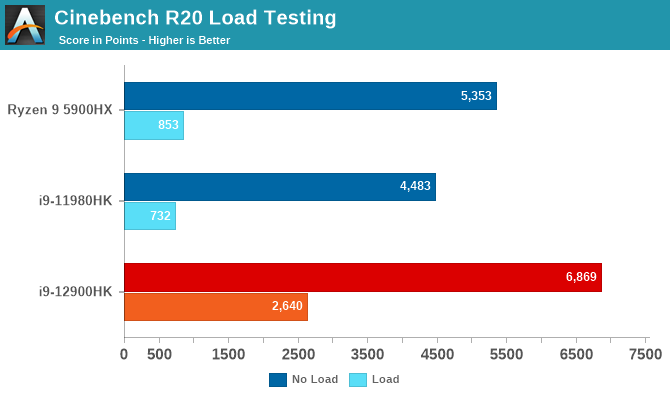
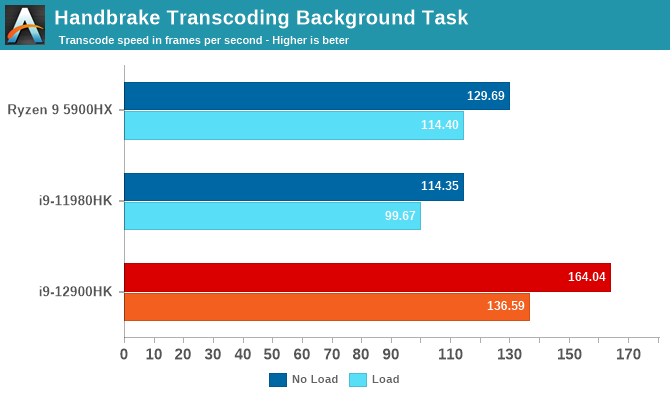
The results are very interesting and prove that Intel’s new Thread Director, coupled with Windows 11, makes a big difference in terms of usability. On PCMark 10, all the systems dropped in performance the smallest percentage, as this test is not just about the CPU, but the Alder Lake Core i9-12900HK dropped the least, with an overall result that was 82.6% of the original unloaded result. The Tiger Lake system was only able to achieve 61.9% of its original result, while the AMD system fared better at 75%.
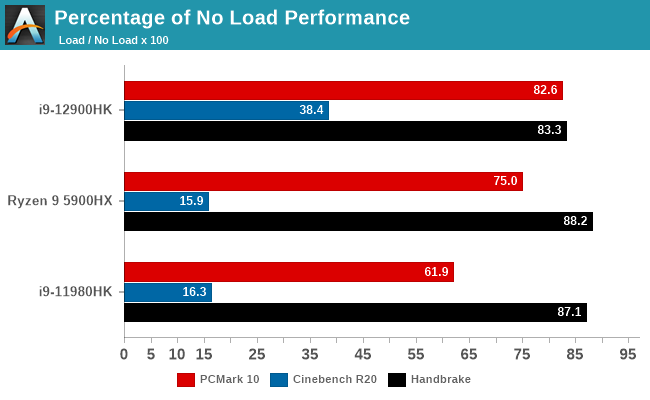
Cinebench though was a different story, with both the Ryzen 9 5900HX and the Tiger Lake i9-11980HK only able to achieve about 16% of their original result, whereas the new Alder Lake system was still able to net 38.4% of its original score while the system was using every single core to transcode a video.
With Handbrake running in the background, all the systems were slower to transcode, but both the AMD 5900HX and Intel i9-11980HK, thanks to not being able to de-prioritize the background task, finished the transcode with a frames per second average of about 88% of the unloaded transcode would have achieved. The new Alder Lake system could only average 83% of its original frames per second, because that task was deprioritized by Thread Director to free up additional resources for the foreground jobs. That made a sizable difference on the net for all the jobs, especially Cinebench.
The new Thread Director and hybrid design is a big win for usability. No longer does an active task feel like it bogs down the system, leaving the user with an unresponsive computer to deal with. Even with the CPU running at 100% load, active tasks feel quick and net performance is very impressive. Although the Alder Lake system did give up the most performance on the background task, it was only an additional 4% over the Tiger Lake system, while at the same time achieving a much higher result on the foreground task. On Cinebench, the Alder Lake system scored 3.6 times higher than the Tiger Lake platform, while still achieving a transcode that was 1.37 times faster. It is very impressive.


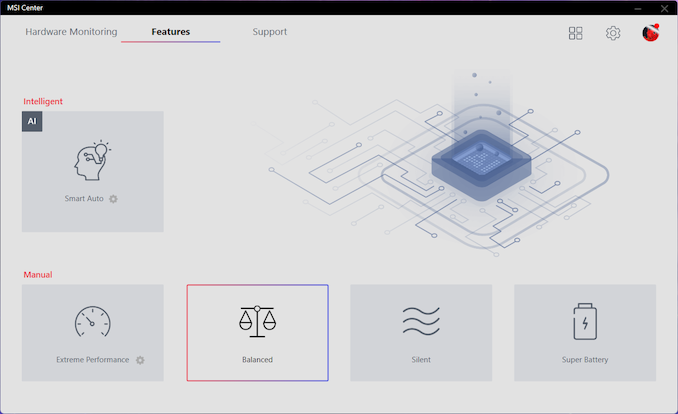








153 Comments
View All Comments
tkSteveFOX - Wednesday, January 26, 2022 - link
Just a note for Brett here, when you do a laptop review thermals, throttling and noise levels are important things to have in the review.Brett Howse - Wednesday, January 26, 2022 - link
This isn't a laptop review. Please check the link to the GE 76 Raider review we did in September.TheinsanegamerN - Friday, January 28, 2022 - link
*reviews laptop CPU**uses laptop*
*this is not a laptop review*
Whew, anandtech quality ladies and gentlemen! I guess that throttling and thermals are not important in CPU tests either? Or would that get in the way of using RAM to exuse the hideous power draw?
corinthos - Wednesday, January 26, 2022 - link
Whole point of a laptop is portability and using unplugged for a considerable amount of the time. That's why you pay a premium. If the best Intel can do is 3.x hours on battery, this is essentially a desktop alternative/replacement, in which case you get even more for your money just buying a desktop.Brett Howse - Wednesday, January 26, 2022 - link
This is literally a desktop replacement. That's actually a product category for notebooks.Spunjji - Thursday, January 27, 2022 - link
I'm sorry you have to keep replying to comments like this...Spunjji - Thursday, January 27, 2022 - link
For me, those "percentage of no load performance" graphs may have been the most interesting. It certainly shows what Alder Lake can offer when it's being used to the fullest. It doesn't represent a use-case that I'd ever put a laptop to, but it will be very interesting for the sort of user for whom 20 threads in a mobile CPU is less a flashy selling point and more a necessity.Otherwise it's looking as I expected - peak performance is significantly better than the ageing Cezanne platform, sustained performance in a slightly more representative platform remains to be seen. Tiger Lake H was ~25% down on Cezanne in terms of performance/watt in multithreaded loads, so there's certainly potential here for Intel to have caught up and maybe even surpassed that.
abufrejoval - Thursday, January 27, 2022 - link
The least impressive statement in this review is this “Perhaps the most impressive result though is Intel’s Thread Director, which provides very impressive system responsiveness even when the system is at 100% CPU load…”, because to me it sounds either like paid content or lack of reflection.Intel is pushing E-cores as a “must have”, because it’s exclusive to their platform, very much like MMX or AVX-512 back then.
But it’s mostly yet another marketing smoke bomb.
I am convinced you could achieve a very similar gain in responsiveness by emulating the 8 E-cores via the 2 P-cores they replace in terms of silicon real-estate on Alder Lake. What you perceive as a hardware benefit is mostly an OS defect in workload management.
What happens here is that long running batch and latency sensitive interactive workloads are being separated and assigned to hardware partitioned processing pools dependent on whether they are running in the “foreground” or “background”. Doing that in the Windows task manager today, is obviously cumbersome, but writing a tool that prohibits the usage of all CPU cores once workloads are switched to background, should be trivial enough. And to my knowledge even cache partitioning has been part of x86 since Broadwell to ensure that busy background batch tasks won’t flush latency sensitive interactive workloads entirely from them.
Yes, E-cores have been proven to squeeze longer run times out of smartphones or more concurrent session support per Watt in certain cloud servers, because they are designed to be more efficient in in terms of instructions per Watt/h at the price of instructions per unit of time.
But those constraints do not apply to a gaming laptop or most desktop computers. Actually, even on ultra-thin laptops CPU core power consumption is becoming a rather insignificant contributor to overall energy spend, outside of some synthetic fringe cases.
Intel fits 8 E-cores into a similar space for 2 P-cores, so the high-end mobile Alder-Lake parts could just be 8 P cores or 32 E cores or any of the other permutations. And quite obviously you would be able to find workloads with an ideal fit for each, just as you’d also find workloads that violate either performance or efficiency targets on them.
Intel promotes a hardware partitioned compromise between E- and P-cores and then interestingly charges an E-core premium on desktop parts, where collective energy savings on remotely managed always-on volume parts might actually provide an ecological benefit. But I can’t help thinking, that a software solution via “E-core emulation” would deliver more flexibility and adjustable performance on most laptops and workstations and prefer 8P+0E over 6P+4E practically everywhere except server parts.
Bik - Thursday, January 27, 2022 - link
Simple thought will prove this correct: a big task that feels like it bogs down the whole system, will no longer be so if you willing to sacrify some cores for background tasks. The scheduler just isnt smart enough to do that today.There's another thing I notice. When it is true that 8-E cores put up more performance than 2-P cores, Intel claims of silicon real-estate between the two being equal may not be correct. Because if they do, we'll surely have all E-cores cpu for heavy multi-thread work loads. But that didnt, and I doubt, will ever happen.
diediealldie - Thursday, January 27, 2022 - link
oh, they will. There's Sierra Forest AP which consists of 128 e-cores. Intel is not making all e-cores yet since launched platforms are kind of mass-market general-purpose ones which need high ST performance along with good MT performance.